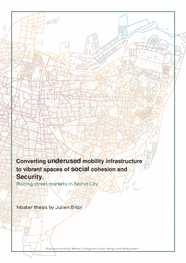
Converting underused mobility infrastructure to vibrant spaces - Placing street markets in Beirut City
Master Thesis by Julien Bitar
Study Programme Integrated Urban Development & Design
2020
In this Master Thesis Julien Bitar uses parametric analysis tools to investigate potentials for street markets in the capital of Lebanon - Beirut.

Placing street markets in Beirut City - Julien Bitar (IUDD Master Thesis, 2020)
Click the Play button to load and view external content from Vimeo.com.
Automatically load and view external content from Vimeo.com (You can change this setting at any time via our »Data protection policy«.)
Beirut is Lebanon’s densest city with very few unbuilt plots. Additionally, it is a car based city, where transportation is exclusive to private automobiles, hence most of the public space in the city is dedicated to vehicles. This generates a great deal of car pressure on the public space, especially since there are no proper public transport network in the city. However, this situation is not permanent, and the city will eventually adopt a public mobility strategy, as the public is insisting on this demand nowadays. On the other hand, most of the urban blocks in Beirut are considered relatively small, creating more streets than usual or needed, from which, some are insignificant to the mobility network in the city. That being said, Public spaces such as streets, can be rethought of, and transformed from car infrastructure to pedestrian spaces, for an optimal use of space in dense cities such as Beirut. These spaces could host functions the city needs today more than ever such as markets and public pedestrian areas. This aligns perfectly with the sever economic crises Lebanon is going through, where people are losing their jobs and all type of goods are becoming unattainable. Today, people need access to affordable goods, adopt a new way of trading, and for this they need suitable spaces, most importantly free outdoor spaces in dense urban areas.
Therefore this Master Thesis investigates how underused mobility infrastructure can host vibrant spaces of social cohesion and security. The idea behind this thesis is to build up a method that allows to assign functions such as markets and pedestrian areas to certain streets which can be closed down to cars, or where car access is reconsidered. This method is based on several parameters, such as parking availability, width and length of the street to properly accommodate markets, uninterrupted flow of goods and waste to and out of the city without adding congestion, and most importantly how to least affect the traffic flow and centrality in the city. Parametric tools are used to test the pressure on the current street network, choose streets which would not affect the mobility network, set the mentioned parameters to filter out the streets which fulfill the necessary criteria. The result is a set of streets fitting the criteria successfully to be used for markets/trading spaces as well as pedestrian area, making the city more livable.

